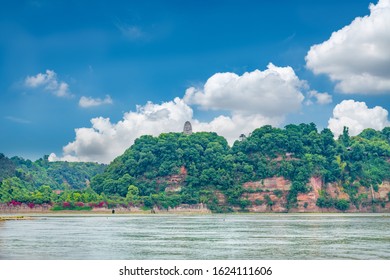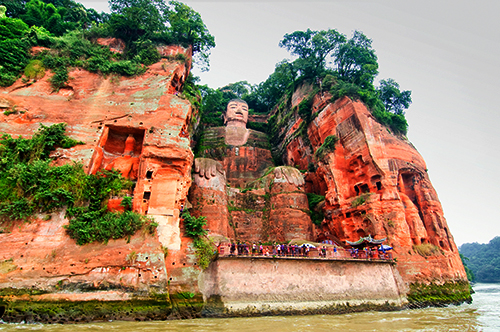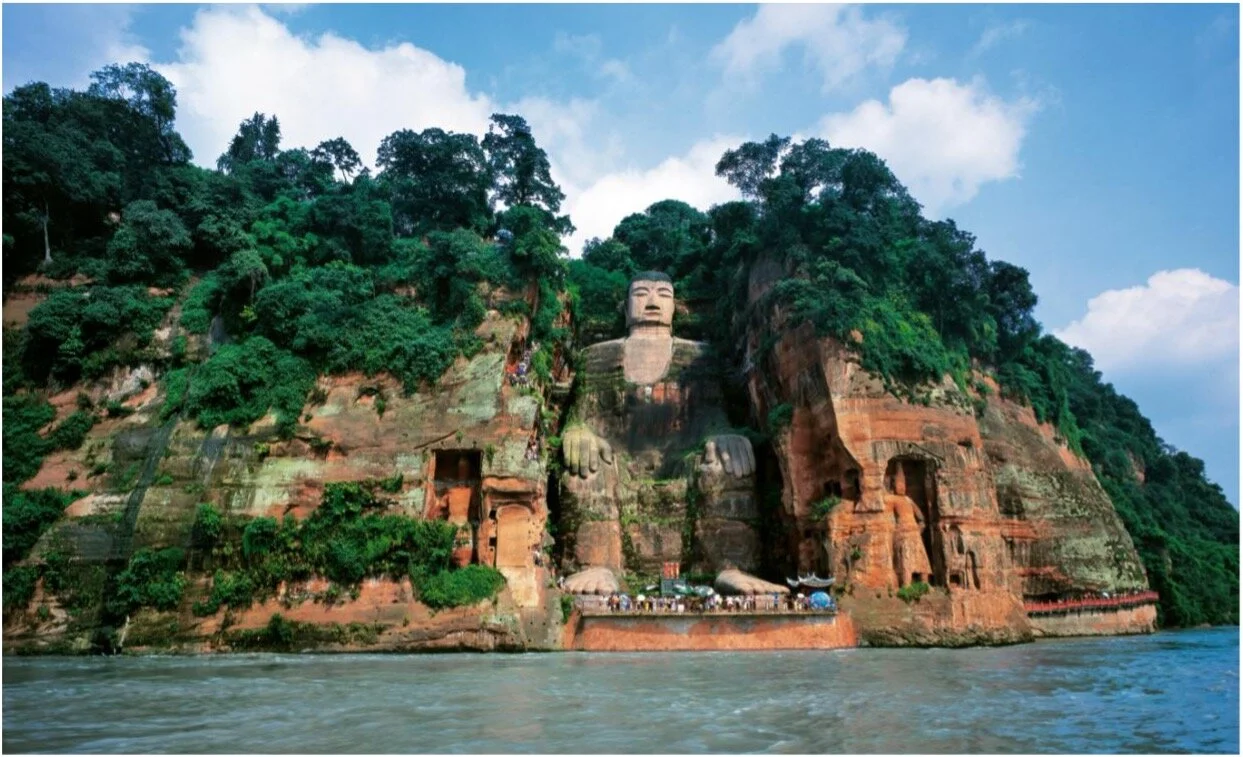Journey to the Heart of Sichuan: What You Need to Know About the Leshan Giant Buddha
An Essential Guide to Visiting Leshan Giant Buddha
Standing sentinel over the confluence of three rivers, the Leshan Giant Buddha is not just a statue; it’s a colossal marvel carved into the cliffside, towering at an impressive 71 meters. As the largest Maitreya Buddha in the world, this UNESCO World Heritage Site embodies both artistic genius and spiritual significance, captivating the hearts of pilgrims and travelers alike.
In this guide, we will explore the essential aspects of visiting the Leshan Giant Buddha, including its rich history, cultural importance, and the best ways to experience its grandeur. From practical tips on opening hours and ticket prices to insights on the most scenic views and nearby attractions, this comprehensive resource aims to ensure your visit is as memorable and smooth as possible. Prepare to embark on an unforgettable journey into the heart of Sichuan’s breathtaking landscapes and the profound serenity of one of China’s most iconic landmarks.
In This Guide
- An Essential Guide to Visiting Leshan Giant Buddha
- The Rich History and Legends of Leshan Giant Buddha
- Main Highlights: What You Absolutely Can’t Miss
- Planning Your Visit: A Practical Guide
- Tickets: Prices, Booking, and Tips
- How to Get There: A Complete Transportation Guide
- Local Cuisine and Accommodation Nearby
- Frequently Asked Questions
- Final Thoughts on Your Trip
The Rich History and Legends of Leshan Giant Buddha
A Marvel of Ancient Engineering and Spiritual Significance
Nestled in the picturesque Sichuan province, the Leshan Giant Buddha, standing majestically at 71 meters (233 feet), is not just an architectural marvel; it embodies a rich tapestry of history, culture, and spirituality. Carved into the cliffs overlooking the convergence of three rivers, this colossal statue has been a beacon of reverence and pilgrimage for centuries.
The Origins of the Giant Buddha
The construction of the Leshan Giant Buddha began during the Tang Dynasty, around 713 AD, initiated by a monk named Haitong. Frustrated by the treacherous waters that claimed countless lives, Haitong envisioned a guardian figure that would protect sailors navigating the turbulent rivers of the region. He passionately dedicated himself to this monumental task, gathering artisans and laborers to carve the Buddha directly into the cliffside.
The project spanned over 90 years and was marked by numerous challenges. Reports suggest that Haitong even sacrificed his eyesight to ensure the statue’s completion, a testament to his unwavering devotion. His legacy, however, did not end with the statue’s completion, as the Giant Buddha quickly became a focal point for religious gatherings and a symbol of hope for the local community.
Architectural Ingenuity
The Leshan Giant Buddha is not just remarkable for its size but also for its engineering prowess. The statue was designed to withstand the elements, with drainage systems cleverly integrated into its structure to prevent erosion. This foresight has allowed it to endure for over a millennium, showcasing the advanced techniques of Tang Dynasty craftsmen.
In 1996, the Leshan Giant Buddha was designated a UNESCO World Heritage Site, recognizing its cultural significance and the craftsmanship involved in its creation. This accolade further cemented its status as one of China’s most revered landmarks.
Legends and Folklore
Throughout its history, the Leshan Giant Buddha has inspired countless legends and anecdotes. One of the most famous tales involves the spirit of the Buddha himself. Local folklore suggests that the statue’s eyes are said to follow visitors as they walk by, creating an ethereal connection between the observer and the statue. This phenomenon has led many to believe that the Giant Buddha is not merely a statue but a guardian spirit watching over the waters and the people of Leshan.
Another popular legend recounts the story of how the rivers calmed after the Buddha’s completion. As the tale goes, once the statue was unveiled to the public, the turbulent waters of the Minjiang, Dadu, and Qingyi rivers transformed into a serene flow, reducing the risks faced by passing ships. This miraculous change further solidified the belief in the Buddha’s protective powers.
Pilgrimage and Cultural Significance
Over the centuries, the Leshan Giant Buddha has attracted pilgrims and tourists alike, becoming a vital part of Buddhist practice in the region. Every year, thousands of devotees flock to the site to pay their respects and seek blessings. The surrounding area is dotted with temples and shrines, each adding layers to the spiritual ambiance.
The annual festival of the Giant Buddha is a highlight for many locals and visitors. This celebration features traditional performances, rituals, and offerings that honor the statue and its significance in the Buddhist faith.
Conclusion: A Lasting Legacy
Today, the Leshan Giant Buddha stands not only as a testament to ancient craftsmanship but also as a symbol of protection, spirituality, and cultural heritage. Whether viewed from the land or by boat, the sight of this monumental figure inspires awe and reverence, reminding us of the rich history and legends that have shaped its existence. For international travelers, visiting the Leshan Giant Buddha is an opportunity to connect with the deep-rooted traditions of China and to witness a marvel that continues to resonate through the ages.

Leshan Giant Buddha.
Main Highlights: What You Absolutely Can’t Miss
The Leshan Giant Buddha
Standing majestically at 71 meters, the Leshan Giant Buddha is the world’s largest stone Buddha statue, carved into a cliff face during the Tang Dynasty. This UNESCO World Heritage Site is not only a marvel of engineering but also a spiritual sanctuary. Here’s what you absolutely can’t miss during your visit to this iconic site.
1. The Buddha’s Enormous Face
As you approach the statue, you’ll be struck by the serene expression of the Buddha’s face. The intricate details, from the gentle lilt of its lips to the tranquil gaze, are mesmerizing. Don’t forget to capture a close-up photo from the viewing platforms; the sheer scale will leave you in awe. Tip: Arrive early in the morning to avoid crowds and enjoy the peaceful atmosphere.
2. Nine Bends Plank Road
For those seeking adventure, the Nine Bends Plank Road offers a scenic hiking experience that winds down the cliffside. This wooden pathway leads you directly to the feet of the Buddha, providing stunning views along the way. Tip: Wear comfortable shoes as the hike involves steep sections and numerous steps, but each bend reveals a new perspective of the Buddha.
3. Lingyun Temple
Nestled nearby, Lingyun Temple offers a serene escape and a chance to appreciate Tang architecture. The temple holds historical significance and provides excellent vantage points to photograph the Buddha’s head. Tip: Visit during the late afternoon when the sunlight bathes the statue in a warm glow, creating a fantastic backdrop for your photos.
4. Boat Tour on the Rivers
For a unique view of the Buddha, consider taking a boat tour on the Minjiang, Dadu, and Qingyi rivers. This one-hour cruise offers a different perspective, showcasing the statue’s grandeur against the lush surrounding landscape. Tip: Book your boat ticket in advance to secure your spot, especially during peak tourist seasons.
5. Wuyou Temple
Directly across from the Giant Buddha, Wuyou Temple provides a peaceful ambiance away from the crowds. It’s an ideal spot for reflection and relaxation, with beautiful courtyards and intricate carvings. The temple also offers stunning views of the Buddha, perfect for photography. Tip: Take some time to explore the temple grounds and enjoy the tranquil setting.
6. The Giant Sleeping Buddha
As you explore the area, keep an eye out for the naturally occurring formation known as the Giant Sleeping Buddha. It resembles a reclining Buddha from a distance and is a fascinating sight that adds to the overall experience. Tip: Bring binoculars or use your camera’s zoom to appreciate the details of this unique formation.
7. Scenic Area Exploration
The Leshan Giant Buddha Scenic Area is rich in natural beauty and cultural heritage. Beyond the Buddha, you’ll find lush gardens, winding paths, and other historical relics. Allocate enough time to wander through the scenic area, enjoying the blend of nature and history. Tip: Keep your camera ready; you never know when you’ll stumble upon a picturesque view or a serene moment.
Conclusion
A visit to the Leshan Giant Buddha is not just about witnessing one of the world’s largest statues; it’s about immersing yourself in the rich history and spiritual significance of the site. With these highlights, you’re sure to have an unforgettable experience in this breathtaking part of China.

Leshan Giant Buddha.
Planning Your Visit: A Practical Guide
Best Time to Visit
The Leshan Giant Buddha can be visited year-round, but the most favorable time is during spring (March to May) and autumn (September to November). During these seasons, the weather is mild, making it comfortable for exploring the scenic area. Summer can be quite hot and crowded, while winter might bring cooler temperatures but fewer tourists. Keep in mind that the opening hours vary: from 8 AM to 5:30 PM in the warmer months and 8:30 AM to 5 PM in the colder months.
Recommended Itinerary
To make the most of your visit, consider this suggested itinerary:
-
Morning Arrival: Depart from Chengdu early in the morning (a high-speed train takes about an hour). Aim to arrive around 9 AM to beat the crowds.
-
Explore the Scenic Area: Begin your exploration at the Leshan Giant Buddha Scenic Area. Choose between a walking tour (2-3 hours) or a boat tour (1 hour) to enjoy stunning views of the statue.
-
Visit the Temples: After touring the Buddha, visit Wuyou Temple for panoramic views and a peaceful atmosphere. Don’t miss Lingyun Temple, which showcases Tang architecture.
-
Lunch Break: Enjoy a local meal at one of the nearby restaurants. Sichuan cuisine is famous for its bold flavors and spice.
-
Afternoon Activities: Spend some time exploring the surrounding scenic area, including the Giant Sleeping Buddha formation and scenic hiking trails.
-
Evening Return: Head back to Chengdu in the late afternoon or early evening.
Photography Tips
- Golden Hour: For stunning photographs, visit during the golden hour (early morning or late afternoon) for soft lighting that enhances the Buddha’s features.
- Boat Tours: Capture the Buddha from the water for a unique perspective. Consider bringing a zoom lens for close-up shots.
- Wide-Angle Lens: A wide-angle lens is ideal for capturing the scale of the Buddha and the surrounding landscape.
- Include People: Incorporate visitors in your shots to convey the scale of the statue and the atmosphere of the site.
What to Wear
- Comfortable Shoes: Wear sturdy, comfortable footwear, especially if you plan to hike or take the walking tour as there are steep paths and many stairs.
- Weather-Appropriate Clothing: Dress in layers to adapt to changing temperatures, especially if visiting in spring or autumn.
- Sun Protection: Bring a hat, sunglasses, and sunscreen, particularly in summer when the sun can be intense.
Insider Tips
-
Buy Tickets in Advance: To save time, purchase your tickets online or at the train station. This helps you avoid long queues upon arrival.
-
Visit on Weekdays: If possible, plan your visit on a weekday to experience fewer crowds, allowing for a more serene experience.
-
Explore Beyond the Buddha: Take time to explore the lesser-known attractions in the area, such as the nearby temples and hiking trails for a more comprehensive experience.
-
Stay Hydrated and Snack Ready: Bring water and light snacks, especially if you plan to hike. There are limited food options once you’re inside the scenic area.
-
Check for Local Events: Look out for local festivals or events that might be happening during your visit, as they can enhance your experience with cultural performances and activities.
With these tips and insights, you’re well-prepared to embark on an unforgettable journey to the Leshan Giant Buddha, one of China’s most remarkable cultural treasures!

Leshan Giant Buddha.
Tickets: Prices, Booking, and Tips
Visiting the Leshan Giant Buddha is a remarkable experience, and knowing the ticketing details can enhance your trip. Below is a comprehensive overview of the ticket options available to ensure you’re well-prepared for your visit.
| Ticket Type | Price (CNY) | Includes |
|---|---|---|
| Leshan Giant Buddha Scenic Area | 80 | Access to the scenic area and the Giant Buddha |
| Boat Tour | 70 | One-hour boat ride to view the Buddha from the water |
Booking Information
To make the most of your visit, it is highly advisable to book your tickets in advance. You can purchase tickets online through various travel agencies or directly at the site. However, given the popularity of the Leshan Giant Buddha, securing your tickets ahead of time can help you avoid long queues and ensure availability, especially during peak tourist seasons.
Tip: Consider combining your entry ticket with a boat tour for a more comprehensive experience of the area. The boat tour offers a unique perspective of the Buddha, although it may not allow for a close-up view of the intricate details.
Additional Tips
- Best Time to Visit: Try to visit during the shoulder seasons (spring and autumn) for pleasant weather and fewer crowds.
- Plan for Your Visit: Allocate approximately four hours for your visit to fully appreciate the site. This includes time for both walking and taking the boat tour.
- Be Prepared: Wear comfortable shoes and pack water, especially if you choose to hike the scenic paths.
By organizing your tickets in advance and planning your visit, you can fully immerse yourself in the grandeur and cultural significance of the Leshan Giant Buddha. Enjoy your adventure!
How to Get There: A Complete Transportation Guide
From the Nearest Major City: Chengdu
By High-Speed Train
The most convenient way to reach the Leshan Giant Buddha is by taking a high-speed train from Chengdu. Trains depart from Chengdu East Railway Station and take about 1 hour to arrive at Leshan South Railway Station. The cost for a second-class ticket is approximately RMB 50-80 (around $7-12 USD). Trains run frequently throughout the day, usually every 30 minutes, making it an efficient option for international travelers.
By Bus
If you prefer a more budget-friendly option, buses are available from Chengdu’s Xinnanmen Bus Station to Leshan. The journey takes approximately 2-2.5 hours, depending on traffic, and tickets cost around RMB 40-60 (about $6-9 USD). Buses depart regularly throughout the day, providing good flexibility for your travel plans.
By Private Car or Taxi
For those who value comfort and convenience, hiring a private car or taking a taxi from Chengdu to Leshan is an excellent choice. The drive typically takes around 1.5-2 hours. The cost for a taxi ride can range from RMB 300-500 (approximately $45-75 USD), depending on traffic and the specific pickup location in Chengdu. This option allows you the freedom to stop along the way for refreshments or sightseeing.
Getting Around the Scenic Area
Once you arrive at the Leshan Giant Buddha Scenic Area, you have several options for exploring the site:
Walking Tour
The most immersive way to experience the Leshan Giant Buddha is by embarking on a walking tour. The scenic area is well-maintained, and trails lead you through lush landscapes, offering fantastic views of the Buddha from various angles. This option generally takes 2-3 hours, so prepare for some moderate hiking. Wear comfortable shoes, as you will encounter steep stairs, especially on the Nine Bends Plank Road.
Boat Tour
If you prefer a more relaxed experience, consider taking a boat tour. The boat ride allows for stunning views of the Giant Buddha from the water, offering a unique perspective of this monumental sculpture. The boat tour lasts about 1 hour and costs around RMB 70 (approximately $10 USD). Tickets can be purchased on-site, and it’s a great way to capture memorable photos without much effort.
Local Transportation
For those who wish to explore the surrounding areas, local taxis and rideshare services are available. These can be convenient for reaching additional attractions like Wuyou Temple and Lingyun Temple, both of which are within a short distance from the main site.
Accessibility Considerations
The scenic area is generally accessible, but some parts can be challenging due to steep paths and stairs. If you have mobility issues or require assistance, it’s advisable to check in advance regarding support services available at the site.
With these transportation options, visiting the Leshan Giant Buddha is easy and enjoyable, allowing you to immerse yourself in the breathtaking beauty and rich history of this UNESCO World Heritage Site.

Leshan Giant Buddha.
Local Cuisine and Accommodation Nearby
When visiting the majestic Leshan Giant Buddha, you’ll want to make the most of your trip by indulging in the local flavors and finding the perfect place to rest after a day of exploration. Nestled in the heart of Sichuan, this area is famous for its culinary delights and diverse accommodation options. Here’s what you can enjoy nearby:
Local Cuisine
-
Sichuan Hot Pot (火锅)
A must-try when in Sichuan, hot pot is a social dining experience where you cook various meats, vegetables, and tofu in a bubbling pot of spicy broth. Be prepared for a flavorful kick, as Sichuan cuisine is known for its bold use of spices and Sichuan peppercorns that create a unique, numbing sensation. -
Mapo Tofu (麻婆豆腐)
This classic dish features silky tofu swimming in a spicy sauce made with minced pork, doubanjiang (fermented broad bean paste), and a medley of spices. It’s a perfect representation of the region’s love for spicy and aromatic flavors. Pair it with steamed rice to balance out the heat. -
Dan Dan Noodles (担担面)
These iconic noodles are served with a savory, spicy sauce made from sesame paste, chili oil, and minced pork. The combination of flavors is simply irresistible, making it a favorite among both locals and visitors. -
Twice-Cooked Pork (回锅肉)
This dish is prepared by first boiling pork belly, then slicing it and stir-frying it with spicy bean paste, bell peppers, and leeks. The result is a rich, savory dish that perfectly captures the essence of Sichuan cuisine.
Accommodation Options
Luxury
- Leshan Grand Hotel (乐山大酒店)
Offering stunning views of the Minjiang River, this luxury hotel features modern amenities, spacious rooms, and a full-service restaurant serving local and international cuisine. With its proximity to the Giant Buddha, it’s an ideal spot for travelers seeking comfort and elegance.
Boutique
- Jinsha International Hotel (金沙国际酒店)
This boutique hotel combines traditional Chinese decor with modern conveniences. It’s located within walking distance of the Leshan Giant Buddha, making it a great choice for those who appreciate a unique atmosphere. The hotel also provides personalized service to enhance your stay.
Budget
- Leshan Youth Hostel (乐山青年旅舍)
Perfect for backpackers and budget-conscious travelers, this hostel offers shared and private rooms at affordable rates. The friendly atmosphere and communal spaces make it easy to meet fellow travelers, and it’s just a short distance from the scenic area.
No matter your taste or budget, the area surrounding the Leshan Giant Buddha provides a delightful culinary journey and comfortable places to stay, ensuring your visit is both memorable and enjoyable.

Leshan Giant Buddha.
Frequently Asked Questions
-
Is the Leshan Giant Buddha suitable for children and the elderly?
Yes, the Leshan Giant Buddha is generally suitable for families, including children and the elderly. However, the walking tour involves some steep sections and stairs, which may be challenging for those with mobility issues. If you’re traveling with young children or elderly family members, consider the boat tour, which provides a scenic view without strenuous hiking. -
Are there English signs and guides available at the site?
Yes, you will find English signs throughout the Leshan Giant Buddha Scenic Area, making it easier for international visitors to navigate. Additionally, audio guides in English are often available for rent, and some guided tours offer English-speaking guides to enhance your experience. -
How much time should I plan for my visit?
We recommend setting aside about four hours to fully explore the Leshan Giant Buddha and its surrounding scenic area. This timeframe allows you to hike, take photographs, and enjoy the beautiful views of the Buddha and the surrounding landscape. -
What are the opening hours and ticket prices?
The Leshan Giant Buddha is open from 8:00 AM to 5:30 PM from March to October, and from 8:30 AM to 5:00 PM from November to February. The entrance ticket for the scenic area is 80 RMB (approximately $12), while a boat ride costs an additional 70 RMB (around $10.50). -
How do I get to the Leshan Giant Buddha from Chengdu?
The most convenient way to reach the Leshan Giant Buddha from Chengdu is by taking a high-speed train, which takes about one hour. Trains depart regularly from Chengdu East Railway Station to Leshan Railway Station. Once in Leshan, you can take a short taxi ride to the scenic area. -
What should I wear and bring for my visit?
Comfortable walking shoes are essential, especially if you plan on taking the walking tour. Dress in layers, as weather conditions can vary throughout the day. It’s also a good idea to bring water, sunscreen, and a camera for capturing the stunning views. -
Are there dining options available at the site?
Yes, there are several dining options within the Leshan Giant Buddha Scenic Area. You can find local restaurants offering Sichuan cuisine, as well as snack stalls selling refreshments. However, it’s advisable to bring some snacks or water, especially if you plan to spend several hours exploring. -
Can I take photographs at the Leshan Giant Buddha?
Absolutely! Photography is encouraged throughout the scenic area, and you’ll find many picturesque spots to capture the grandeur of the Leshan Giant Buddha. Just be respectful of other visitors and the site’s cultural significance while taking photos.
Final Thoughts on Your Trip
Visiting the Leshan Giant Buddha is more than just a sightseeing trip; it’s a journey through time and spirituality, set against the stunning backdrop of China’s natural beauty. As you stand before this monumental statue, carved into the cliffside, you can’t help but feel a deep sense of awe. This UNESCO World Heritage Site, with its rich history and cultural significance, offers a unique glimpse into the artistry and devotion of the Tang Dynasty.
Whether you choose to admire the Buddha from a boat on the river or hike the scenic paths that lead you close to its feet, each perspective provides a different yet equally breathtaking experience. The serenity of the surrounding temples and the lush landscape enhances this profound encounter, making it a memorable part of your travels in Sichuan.
As you wrap up your visit, take a moment to absorb the tranquility and reflection that this sacred site inspires. The Leshan Giant Buddha stands as a reminder of the enduring human spirit and the beauty of devotion. Let this experience resonate within you as you continue your journey, carrying the peace and wonder of the Buddha with you. Embrace the adventure ahead, knowing that sometimes, the most significant memories are found in places that have stood the test of time. Safe travels!